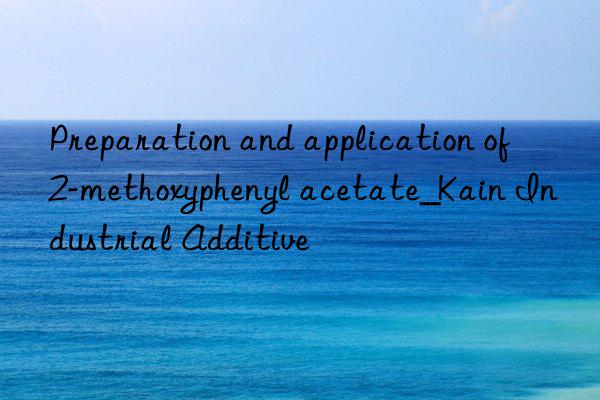
Background and overview[1][2]
Methoxyphenylacetic acid such as o-(p-, m-)methylphenylacetic acid. Among them, 2-methoxyphenyl acetate is an important class of organic chemical fine chemical intermediates, mainly used in the manufacture of pesticides and Medicines and corresponding esters, etc. In the existing technology, there are not many reports on the preparation method of 2-methoxyphenyl acetate, but there are many synthesis and preparation methods of its analogue phenylacetic acid, and its synthesis process routes mainly include the following:
(1) Phenyl acetonitrile hydrolysis method: first use chloride and sodium cyanide in the presence of a solvent to generate phenylacetonitrile, then further react to obtain aryl acetonitrile, and finally hydrolyze in dilute sulfuric acid into aryl acetic acid. This method has a high yield in the hydrolysis step, but the synthesis yield of phenylacetonitrile is low, and sodium cyanide is highly toxic.
(2) Phenylacetamide hydrolysis method: Using styrene as raw material, it reacts with ammonia and sulfur to generate phenylacetamide, and continues the reaction to obtain arylacetamide, which is then hydrolyzed to generate arylacetic acid. This method has a simple process, easy to control operating conditions, and low toxicity of raw materials and intermediate products. However, the by-product of the reaction between styrene, ammonia, and sulfur, phenethyl mercaptan, has a strange smell and pollutes the environment, and the reaction needs to be carried out under pressure, which is limiting. application of this reaction.
(3) Carbon-based synthesis method: Under the action of a carbonation catalyst, chlorinated arylmethane undergoes a carbonation reaction in a two-phase system of sodium hydroxide and organic solvent at lower pressure and mild temperature to generate Sodium arylacetate is then acidified to arylacetic acid. Afterwards, 2-methoxyphenyl acetate is obtained through an esterification reaction. The product of this method has high purity and mild reaction conditions. However, it has the disadvantages of high technical requirements in the process and careful operation to prevent catalyst deactivation or loss. The purpose is The yield still needs to be improved.
Physical and chemical properties and structure[1]
2-Methoxyphenyl acetate is also known as: 1-acetoxy-2-methoxybenzene, 1-acetoxy-2-methoxybenzene, o-methoxyphenol acetate, etc. . 2-Methoxyphenyl acetate is white to slightly pink-cream crystalline powder at room temperature, with a density heavier than water. 2-Methoxyphenyl acetate is stable at room temperature and pressure. Keep the container sealed and It will not decompose if stored in a cool, dry place and avoid contact with oxidizing substances.
Apply[3]
Preparation of o-methoxyphenylacetic acid Schiff base
(2) Add 18.8g (0.1mol) 2-methoxyphenyl acetate, 33ml 80% hydrazine hydrate and 50ml methanol (solvent) into a 250ml three-necked flask, control the temperature to 72°C, and stop the reaction after 2-3 hours , cooled to room temperature and then spin-evaporated to obtain the desired product, which was then recrystallized with ethanol and a white solid precipitated. It was filtered and dried under vacuum. The yield was 95%. The melting point was 99-101°C.
(3) Add 0.9g (5mmol) 2-(2-methoxyphenyl)acetylhydrazide and 20ml ethanol into a 100ml three-necked flask, then add 5ml benzaldehyde and 5ml glacial acetic acid, and react at 80℃ for 5- Leave to cool for 6 hours. No solid will precipitate. Rotary evaporate to obtain a white solid. Recrystallize from ethanol to obtain pure product. Yield: 87%. Melting point: 144-146°C. 1HNMRδ:3.50(m,6H,‑OCH3),3.79(m,2H,‑CH2),7.46(m,8H,ArH),8.04(s,1H,‑CH=N),11.27(s,1H, -NH).
Preparation[2]
In a 500m1 four-necked flask, first add 100 grams of water, and slowly add 240 grams (2.40 mol) of 98% concentrated sulfuric acid while stirring. Later, the temperature was raised to 90°C, and 200 grams (98%, 1.50 mol) of methoxyphenylacetonitrile was slowly added dropwise at 90°C-150°C. During the dropping process, the dropping speed was controlled to ensure that the reaction temperature was not lower than 90°C. After the dropwise addition is completed, keep the temperature and reflux for 5-6 hours, and take samples regularly for analysis. The reaction can be stopped when the o-toluene acetonitrile content (GC) in the material composition in the flask is less than 0.2%. Then add 50 grams of warm water and stir for 10 minutes to dissolve the ammonium bisulfate and cool down. Pour the reaction solution into a beaker, keep it warm for 15 minutes, pour the upper layer of light brown oily material into a 1000 ml beaker containing 400 grams. , while stirring, slowly cool down to precipitate the product, filter to obtain light yellow o-methoxyphenylacetic acid granular wet crude product or crystals, about 260 grams, content (GC) 97.58%.
Put the above crude product into a 2000 ml beaker, add 500-800g of clean water, raise the temperature to 60℃-90℃, slowly add 30% NaOH solution under stirring until pH=8-9 to obtain the corresponding o-methoxybenzene Acetate sodium salt. Later, add activated carbon ((1-5%wt, based on crude o-toluene acetic acid)), stir for 10 minutes, keep warm and let stand for 10 minutes, and filter with suction. The filtrate is then placed in a 2000 ml beaker and added slowly while stirring. 40% H2SO4. Liquid to pH = 2-3; keep warm and let stand for 10-15 minutes, pour the upper layer of light yellow oily material into a 1000 ml beaker containing 400 grams of water, stir and slowly cool down to precipitate the product, filter and use distilled water or Wash twice with clean water to obtain slightly yellow wet particles. After drying at 30-50°C, 202.8g of o-methoxyphenylacetic acid is obtained, with a yield of 90.05% and a melting point of 120-122°C. Through esterification reaction, acetic acid-2 is finally obtained. -Methoxyphenyl ester.
Main reference materials
[1] Cao Ping, Yang Jian, Yang Xiangui, Yao Jie, Wang Yue, & Wang Gongying. (2009). Synthesis of diphenyl carbonate from dimethyl carbonate and phenyl acetate catalyzed by organotitanium compounds. Journal of Catalysis, 30 (1), 65-68.
[2] Chen Can, Liu Aiping, Liu Xingping, & Wang Shengde. (2004). Research on the synthesis of methyl 2-methyl-α-oxyphenylacetate. Yunnan Chemical Industry, 31(6), 9-11.
[3] Kang Pengcheng. (2007). Synthesis and anti-tumor research of 2-(2-chloro-6-fluoroanilino)-5-methylphenylacetate. (Doctoral dissertation, Guangdong Pharmaceutical College).

 微信扫一扫打赏
微信扫一扫打赏

